Abstract
Cancer chemoprevention can be defined as prevention of cancer by the administration of one or more chemical entities, either as individual drugs or as naturally occurring constituents of the diet. Based largely on the time period that chemopreventive agents exhibit activity in animal models of carcinogenesis, they can be classified as inhibitors of carcinogen formation, blocking agents, and suppressing agents. The majority of compounds that inhibit the formation of carcinogens prevent the formation of nitrosamines from secondary amines and nitrite in an acidic environment. Blocking agents are inhibitors of tumor initiation, while suppressing agents are inhibitors of tumor promotion/progression. Many well-characterized chemopreventive agents act at one or more steps in both tumor initiation and promotion/progression. The objective of this paper is to provide a general discussion of the mechanisms through which chemopreventive agents inhibit carcinogenesis. Examples of agents that act through these mechanisms are given; however, a complete listing of effective chemopreventive agents is not possible within the context of this paper. At the conclusion is a brief discussion of future prospects in cancer chemoprevention and obstacles to overcome.
Full text
PDF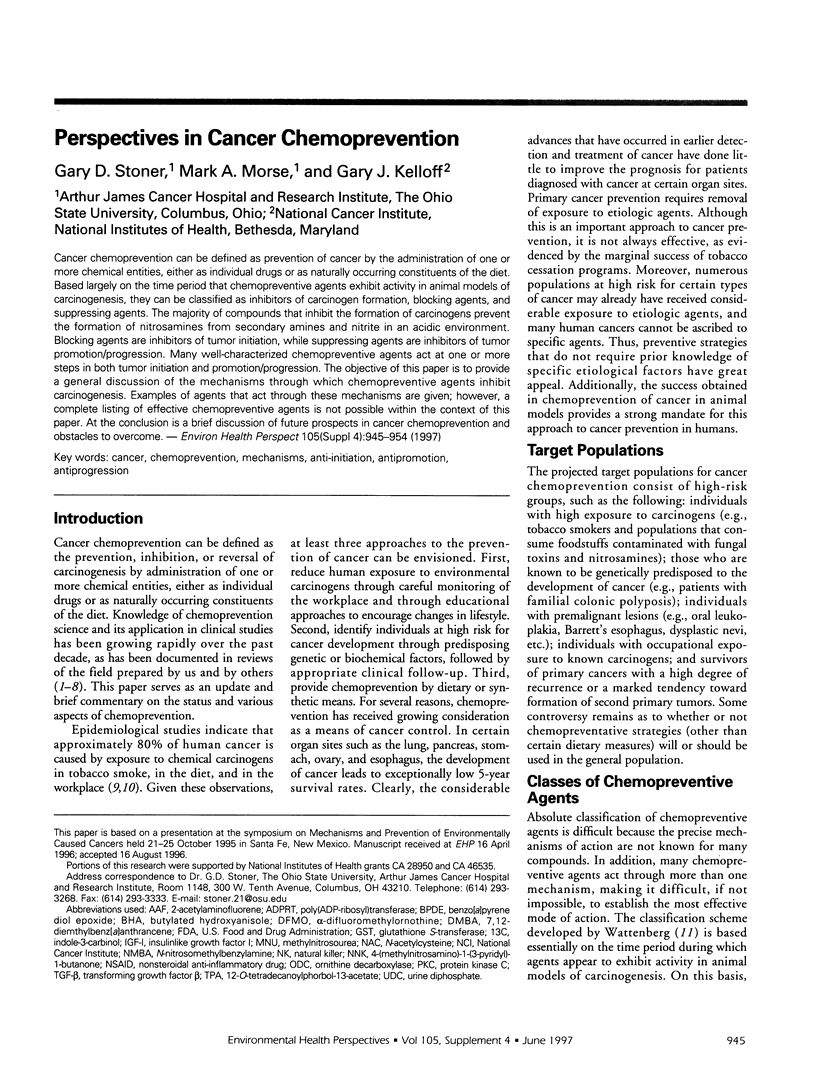
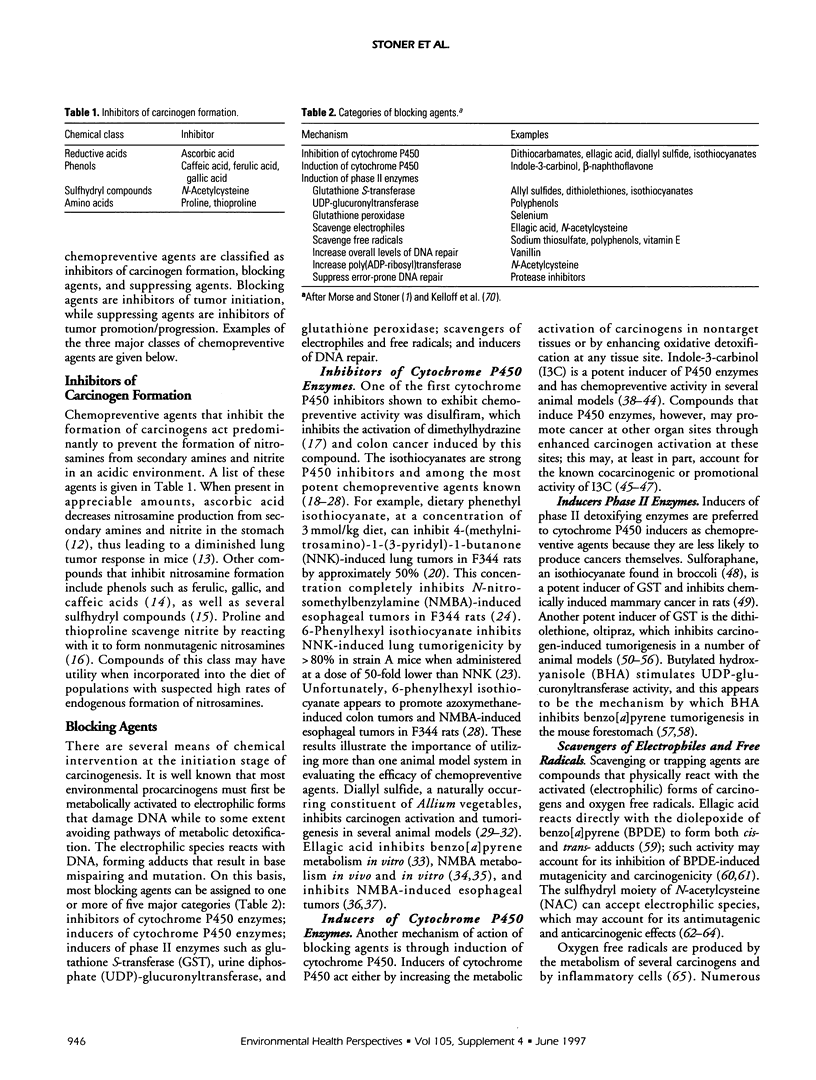
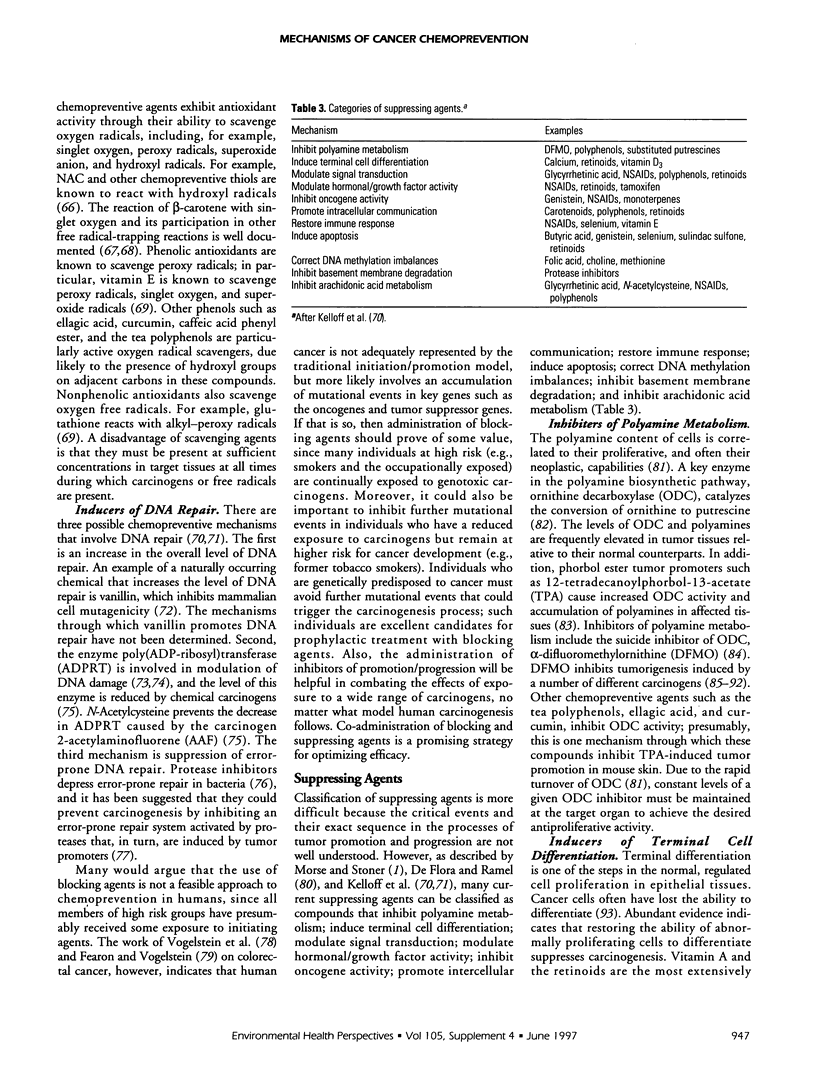
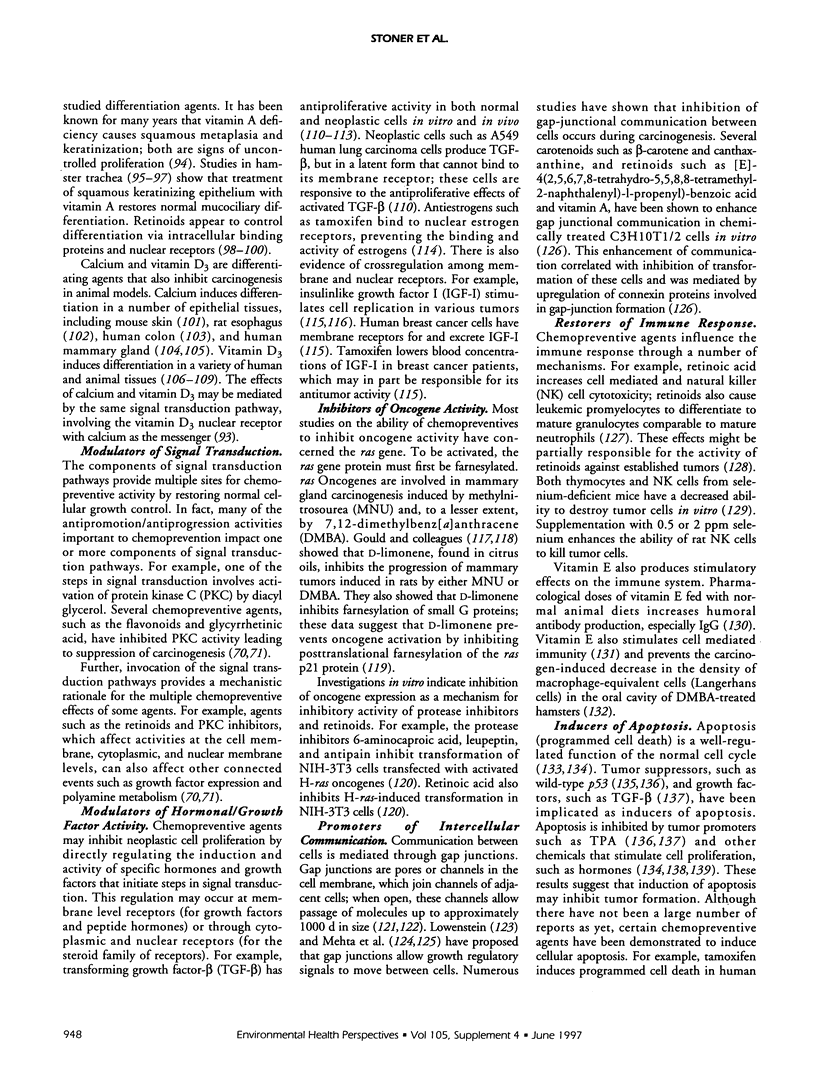
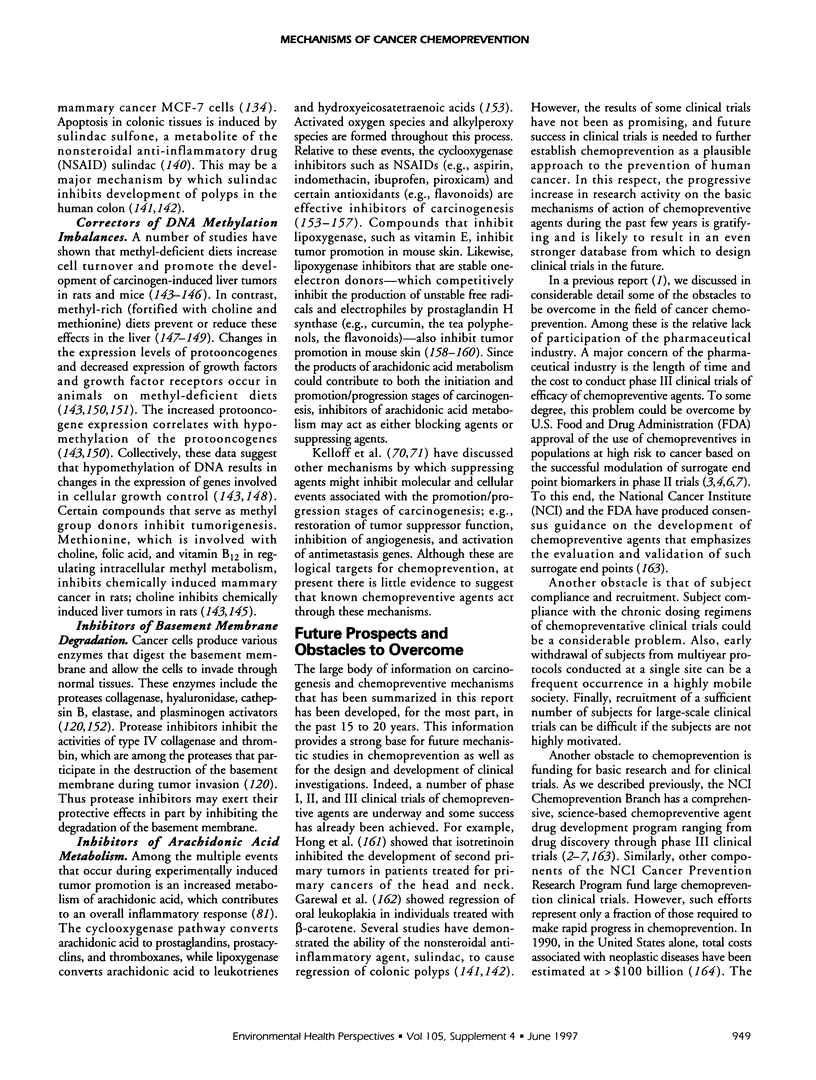
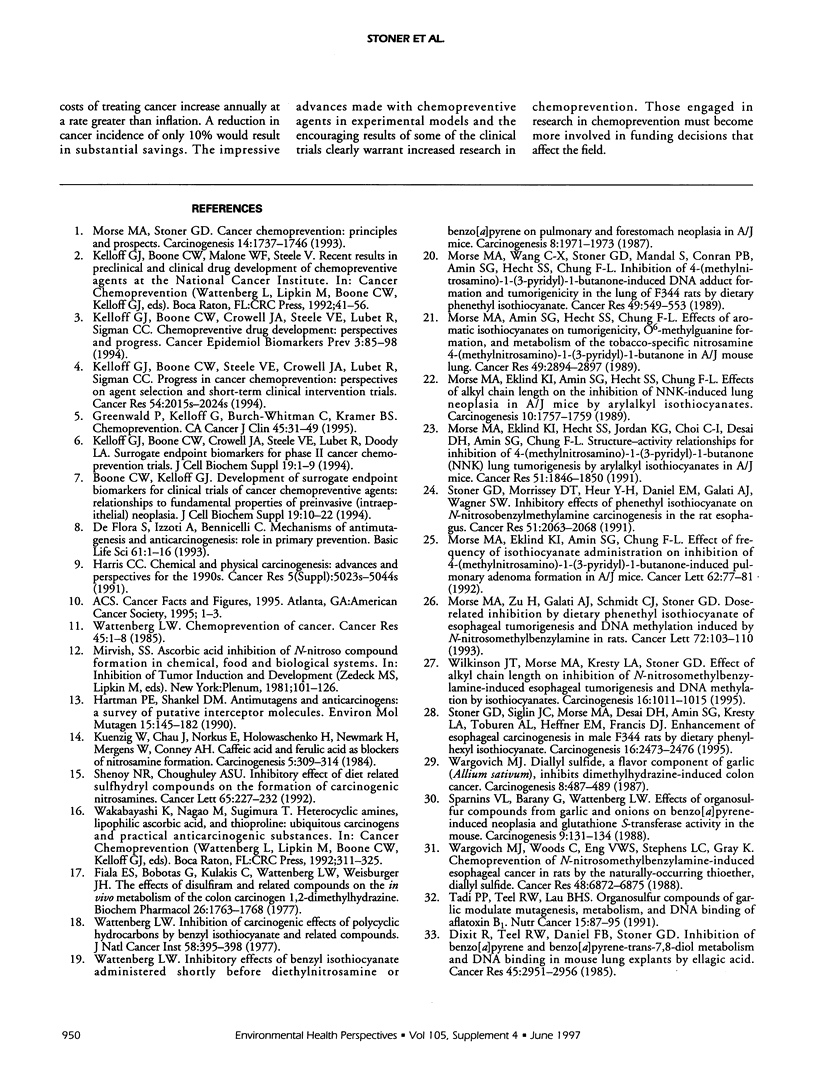
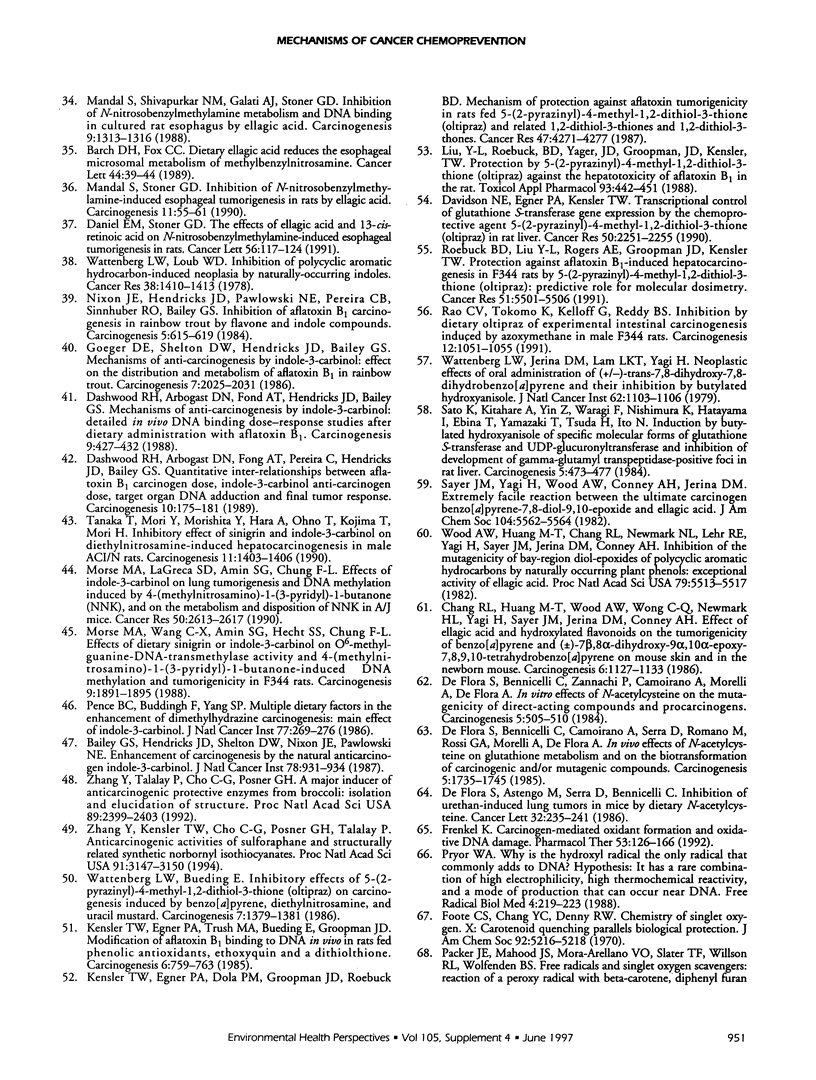
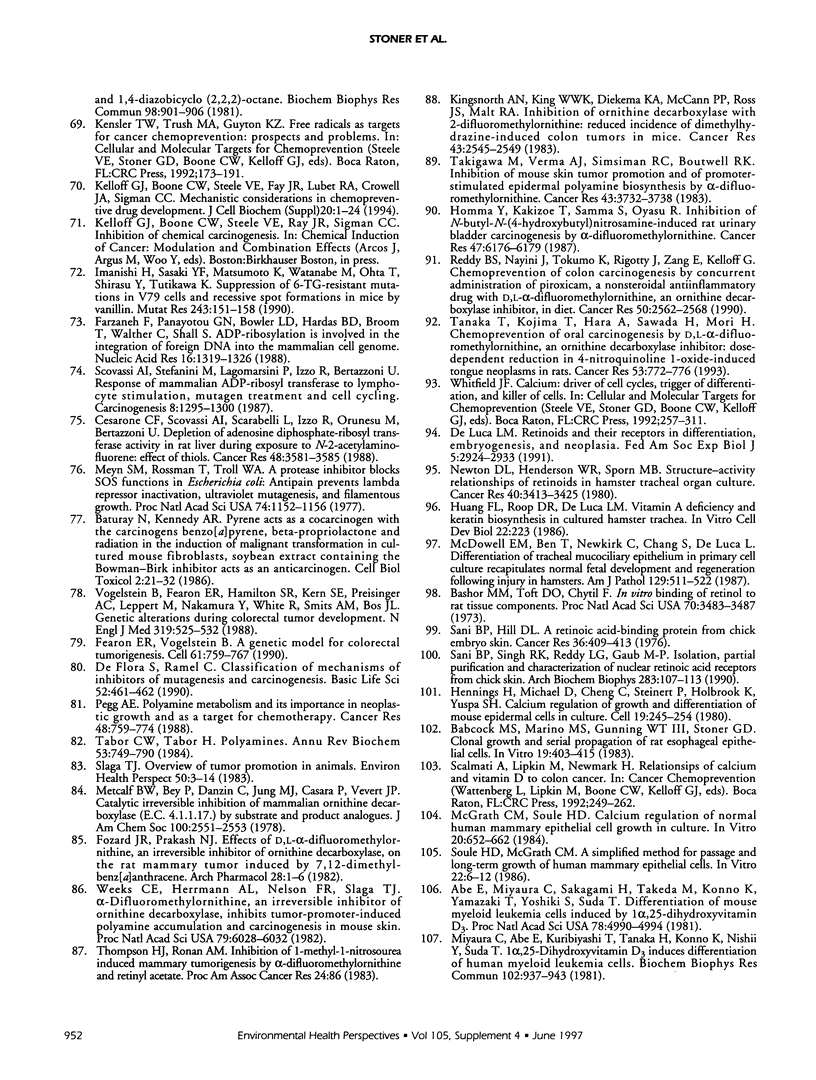
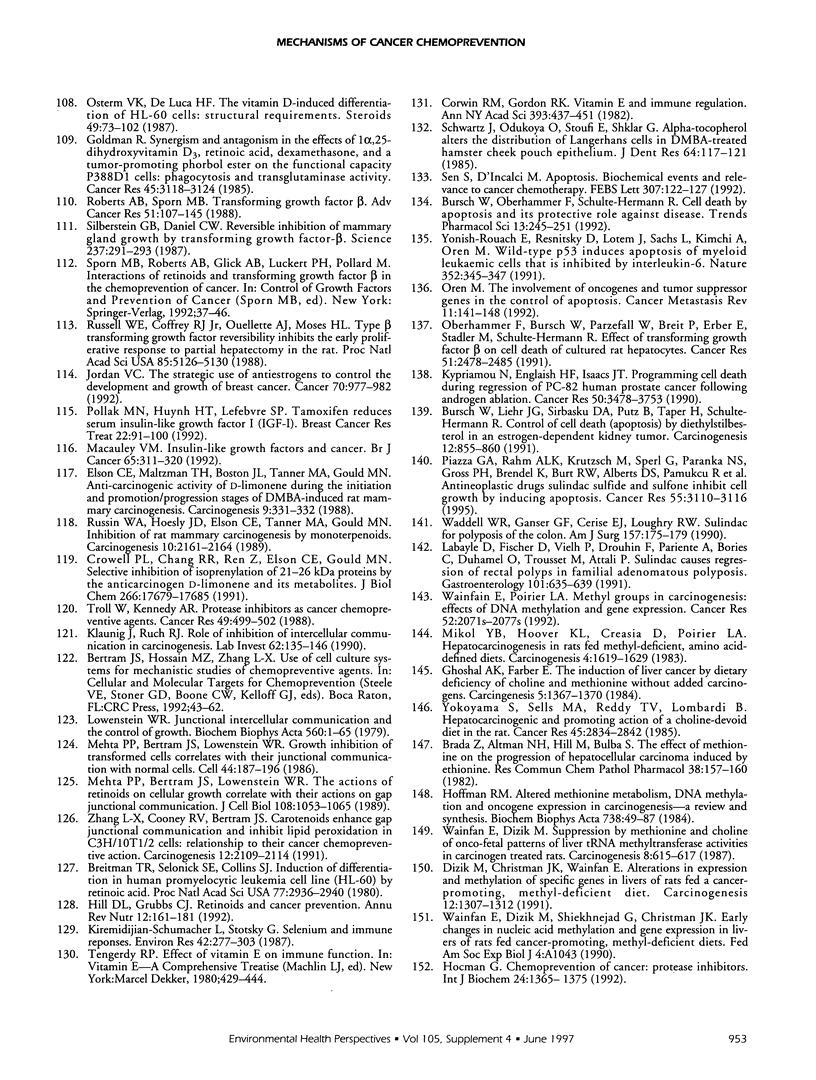
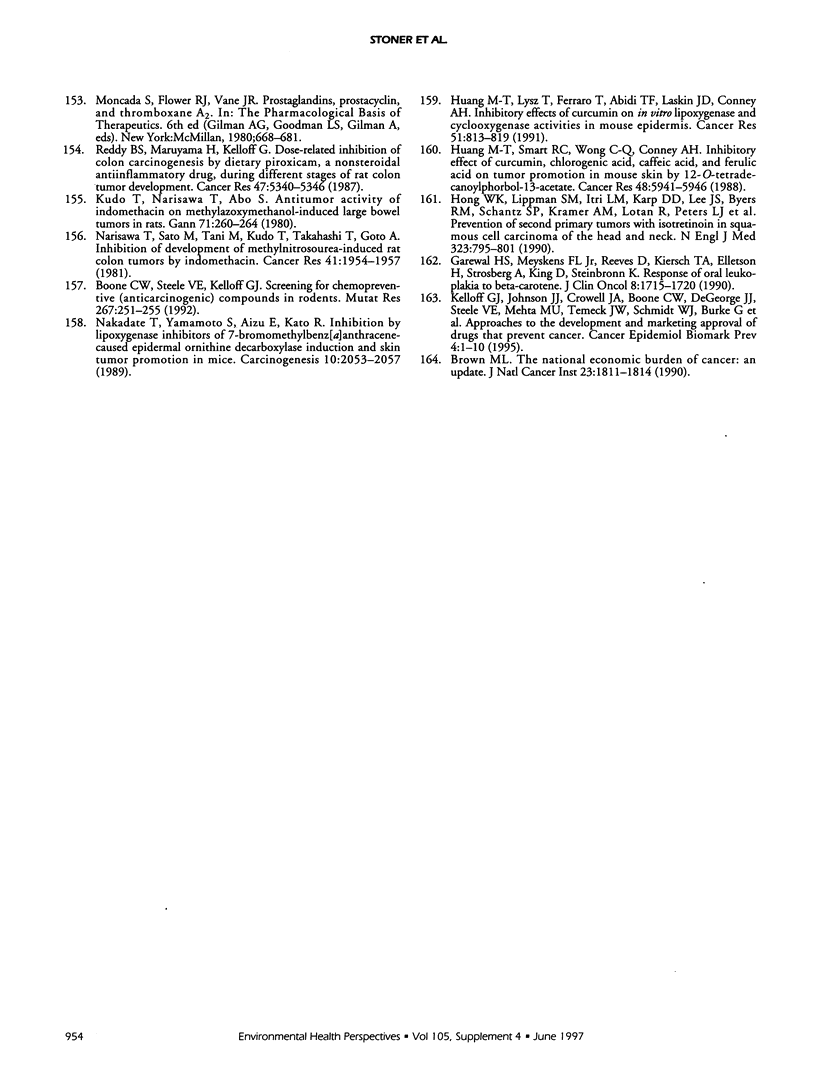
Selected References
These references are in PubMed. This may not be the complete list of references from this article.
- Abe E., Miyaura C., Sakagami H., Takeda M., Konno K., Yamazaki T., Yoshiki S., Suda T. Differentiation of mouse myeloid leukemia cells induced by 1 alpha,25-dihydroxyvitamin D3. Proc Natl Acad Sci U S A. 1981 Aug;78(8):4990–4994. doi: 10.1073/pnas.78.8.4990. [DOI] [PMC free article] [PubMed] [Google Scholar]
- Babcock M. S., Marino M. R., Gunning W. T., 3rd, Stoner G. D. Clonal growth and serial propagation of rat esophageal epithelial cells. In Vitro. 1983 May;19(5):403–415. doi: 10.1007/BF02619557. [DOI] [PubMed] [Google Scholar]
- Bailey G. S., Hendricks J. D., Shelton D. W., Nixon J. E., Pawlowski N. E. Enhancement of carcinogenesis by the natural anticarcinogen indole-3-carbinol. J Natl Cancer Inst. 1987 May;78(5):931–934. [PubMed] [Google Scholar]
- Barch D. H., Fox C. C. Dietary ellagic acid reduces the esophageal microsomal metabolism of methylbenzylnitrosamine. Cancer Lett. 1989 Jan;44(1):39–44. doi: 10.1016/0304-3835(89)90105-5. [DOI] [PubMed] [Google Scholar]
- Bashor M. M., Toft D. O., Chytil F. In vitro binding of retinol to rat-tissue components. Proc Natl Acad Sci U S A. 1973 Dec;70(12):3483–3487. doi: 10.1073/pnas.70.12.3483. [DOI] [PMC free article] [PubMed] [Google Scholar]
- Baturay N., Kennedy A. R. Pyrene acts as a cocarcinogen with the carcinogens benzo[a]pyrene, beta-propiolactone and radiation in the induction of malignant transformation in cultured mouse fibroblasts; soybean extract containing the Bowman-Birk inhibitor acts as an anticarcinogen. Cell Biol Toxicol. 1986 Mar;2(1):21–32. doi: 10.1007/BF00117704. [DOI] [PubMed] [Google Scholar]
- Boone C. W., Kelloff G. J. Development of surrogate endpoint biomarkers for clinical trials of cancer chemopreventive agents: relationships to fundamental properties of preinvasive (intraepithelial) neoplasia. J Cell Biochem Suppl. 1994;19:10–22. [PubMed] [Google Scholar]
- Boone C. W., Steele V. E., Kelloff G. J. Screening for chemopreventive (anticarcinogenic) compounds in rodents. Mutat Res. 1992 Jun;267(2):251–255. doi: 10.1016/0027-5107(92)90069-e. [DOI] [PubMed] [Google Scholar]
- Brada Z., Altman N. H., Hill M., Bulba S. The effect of methionine on the progression of hepatocellular carcinoma induced by ethionine. Res Commun Chem Pathol Pharmacol. 1982 Oct;38(1):157–160. [PubMed] [Google Scholar]
- Breitman T. R., Selonick S. E., Collins S. J. Induction of differentiation of the human promyelocytic leukemia cell line (HL-60) by retinoic acid. Proc Natl Acad Sci U S A. 1980 May;77(5):2936–2940. doi: 10.1073/pnas.77.5.2936. [DOI] [PMC free article] [PubMed] [Google Scholar]
- Brown M. L. The national economic burden of cancer: an update. J Natl Cancer Inst. 1990 Dec 5;82(23):1811–1814. doi: 10.1093/jnci/82.23.1811. [DOI] [PubMed] [Google Scholar]
- Bursch W., Liehr J. G., Sirbasku D. A., Putz B., Taper H., Schulte-Hermann R. Control of cell death (apoptosis) by diethylstilbestrol in an estrogen-dependent kidney tumor. Carcinogenesis. 1991 May;12(5):855–860. doi: 10.1093/carcin/12.5.855. [DOI] [PubMed] [Google Scholar]
- Bursch W., Oberhammer F., Schulte-Hermann R. Cell death by apoptosis and its protective role against disease. Trends Pharmacol Sci. 1992 Jun;13(6):245–251. doi: 10.1016/0165-6147(92)90077-j. [DOI] [PubMed] [Google Scholar]
- Cesarone C. F., Scovassi A. I., Scarabelli L., Izzo R., Orunesu M., Bertazzoni U. Depletion of adenosine diphosphate-ribosyl transferase activity in rat liver during exposure to N-2-acetylaminofluorene: effect of thiols. Cancer Res. 1988 Jul 1;48(13):3581–3585. [PubMed] [Google Scholar]
- Chang R. L., Huang M. T., Wood A. W., Wong C. Q., Newmark H. L., Yagi H., Sayer J. M., Jerina D. M., Conney A. H. Effect of ellagic acid and hydroxylated flavonoids on the tumorigenicity of benzo[a]pyrene and (+/-)-7 beta, 8 alpha-dihydroxy-9 alpha, 10 alpha-epoxy-7,8,9,10-tetrahydrobenzo[a]pyrene on mouse skin and in the newborn mouse. Carcinogenesis. 1985 Aug;6(8):1127–1133. doi: 10.1093/carcin/6.8.1127. [DOI] [PubMed] [Google Scholar]
- Corwin L. M., Gordon R. K. Vitamin E and immune regulation. Ann N Y Acad Sci. 1982;393:437–451. doi: 10.1111/j.1749-6632.1982.tb31282.x. [DOI] [PubMed] [Google Scholar]
- Crowell P. L., Chang R. R., Ren Z. B., Elson C. E., Gould M. N. Selective inhibition of isoprenylation of 21-26-kDa proteins by the anticarcinogen d-limonene and its metabolites. J Biol Chem. 1991 Sep 15;266(26):17679–17685. [PubMed] [Google Scholar]
- Daniel E. M., Stoner G. D. The effects of ellagic acid and 13-cis-retinoic acid on N-nitrosobenzylmethylamine-induced esophageal tumorigenesis in rats. Cancer Lett. 1991 Feb;56(2):117–124. doi: 10.1016/0304-3835(91)90085-v. [DOI] [PubMed] [Google Scholar]
- Dashwood R. H., Arbogast D. N., Fong A. T., Hendricks J. D., Bailey G. S. Mechanisms of anti-carcinogenesis by indole-3-carbinol: detailed in vivo DNA binding dose-response studies after dietary administration with aflatoxin B1. Carcinogenesis. 1988 Mar;9(3):427–432. doi: 10.1093/carcin/9.3.427. [DOI] [PubMed] [Google Scholar]
- Dashwood R. H., Arbogast D. N., Fong A. T., Pereira C., Hendricks J. D., Bailey G. S. Quantitative inter-relationships between aflatoxin B1 carcinogen dose, indole-3-carbinol anti-carcinogen dose, target organ DNA adduction and final tumor response. Carcinogenesis. 1989 Jan;10(1):175–181. doi: 10.1093/carcin/10.1.175. [DOI] [PubMed] [Google Scholar]
- Davidson N. E., Egner P. A., Kensler T. W. Transcriptional control of glutathione S-transferase gene expression by the chemoprotective agent 5-(2-pyrazinyl)-4-methyl-1,2-dithiole-3-thione (oltipraz) in rat liver. Cancer Res. 1990 Apr 15;50(8):2251–2255. [PubMed] [Google Scholar]
- De Flora S., Astengo M., Serra D., Bennicelli C. Inhibition of urethan-induced lung tumors in mice by dietary N-acetylcysteine. Cancer Lett. 1986 Sep;32(3):235–241. doi: 10.1016/0304-3835(86)90175-8. [DOI] [PubMed] [Google Scholar]
- De Flora S., Bennicelli C., Camoirano A., Serra D., Romano M., Rossi G. A., Morelli A., De Flora A. In vivo effects of N-acetylcysteine on glutathione metabolism and on the biotransformation of carcinogenic and/or mutagenic compounds. Carcinogenesis. 1985 Dec;6(12):1735–1745. doi: 10.1093/carcin/6.12.1735. [DOI] [PubMed] [Google Scholar]
- De Flora S., Bennicelli C., Zanacchi P., Camoirano A., Morelli A., De Flora A. In vitro effects of N-acetylcysteine on the mutagenicity of direct-acting compounds and procarcinogens. Carcinogenesis. 1984 Apr;5(4):505–510. doi: 10.1093/carcin/5.4.505. [DOI] [PubMed] [Google Scholar]
- De Flora S., Izzotti A., Bennicelli C. Mechanisms of antimutagenesis and anticarcinogenesis: role in primary prevention. Basic Life Sci. 1993;61:1–16. doi: 10.1007/978-1-4615-2984-2_1. [DOI] [PubMed] [Google Scholar]
- De Flora S., Ramel C. Classification of mechanisms of inhibitors of mutagenesis and carcinogenesis. Basic Life Sci. 1990;52:461–462. doi: 10.1007/978-1-4615-9561-8_50. [DOI] [PubMed] [Google Scholar]
- De Luca L. M. Retinoids and their receptors in differentiation, embryogenesis, and neoplasia. FASEB J. 1991 Nov;5(14):2924–2933. [PubMed] [Google Scholar]
- Dixit R., Teel R. W., Daniel F. B., Stoner G. D. Inhibition of benzo(a)pyrene and benzo(a)pyrene-trans-7,8-diol metabolism and DNA binding in mouse lung explants by ellagic acid. Cancer Res. 1985 Jul;45(7):2951–2956. [PubMed] [Google Scholar]
- Dizik M., Christman J. K., Wainfan E. Alterations in expression and methylation of specific genes in livers of rats fed a cancer promoting methyl-deficient diet. Carcinogenesis. 1991 Jul;12(7):1307–1312. doi: 10.1093/carcin/12.7.1307. [DOI] [PubMed] [Google Scholar]
- Elson C. E., Maltzman T. H., Boston J. L., Tanner M. A., Gould M. N. Anti-carcinogenic activity of d-limonene during the initiation and promotion/progression stages of DMBA-induced rat mammary carcinogenesis. Carcinogenesis. 1988 Feb;9(2):331–332. doi: 10.1093/carcin/9.2.331. [DOI] [PubMed] [Google Scholar]
- Fearon E. R., Vogelstein B. A genetic model for colorectal tumorigenesis. Cell. 1990 Jun 1;61(5):759–767. doi: 10.1016/0092-8674(90)90186-i. [DOI] [PubMed] [Google Scholar]
- Fiala E. S., Bobotas G., Kulakis C., Wattenberg L. W., Weisburger J. H. Effects of disulfiram and related compounds on the metabolism in vivo of the colon carcinogen, 1,2-dimethylhydrazine. Biochem Pharmacol. 1977 Oct 1;26(19):1763–1768. doi: 10.1016/0006-2952(77)90343-4. [DOI] [PubMed] [Google Scholar]
- Foote C. S., Chang Y. C., Denny R. W. Chemistry of singlet oxygen. X. Carotenoid quenching parallels biological protection. J Am Chem Soc. 1970 Aug 26;92(17):5216–5218. doi: 10.1021/ja00720a036. [DOI] [PubMed] [Google Scholar]
- Frenkel K. Carcinogen-mediated oxidant formation and oxidative DNA damage. Pharmacol Ther. 1992;53(1):127–166. doi: 10.1016/0163-7258(92)90047-4. [DOI] [PubMed] [Google Scholar]
- Garewal H. S., Meyskens F. L., Jr, Killen D., Reeves D., Kiersch T. A., Elletson H., Strosberg A., King D., Steinbronn K. Response of oral leukoplakia to beta-carotene. J Clin Oncol. 1990 Oct;8(10):1715–1720. doi: 10.1200/JCO.1990.8.10.1715. [DOI] [PubMed] [Google Scholar]
- Ghoshal A. K., Farber E. The induction of liver cancer by dietary deficiency of choline and methionine without added carcinogens. Carcinogenesis. 1984 Oct;5(10):1367–1370. doi: 10.1093/carcin/5.10.1367. [DOI] [PubMed] [Google Scholar]
- Goeger D. E., Shelton D. W., Hendricks J. D., Bailey G. S. Mechanisms of anti-carcinogenesis by indole-3-carbinol: effect on the distribution and metabolism of aflatoxin B1 in rainbow trout. Carcinogenesis. 1986 Dec;7(12):2025–2031. doi: 10.1093/carcin/7.12.2025. [DOI] [PubMed] [Google Scholar]
- Goldman R. Synergism and antagonism in the effects of 1 alpha,25-dihydroxyvitamin D3, retinoic acid, dexamethasone, and a tumor-promoting phorbol ester on the functional capability of P388D1 cells: phagocytosis and transglutaminase activity. Cancer Res. 1985 Jul;45(7):3118–3124. [PubMed] [Google Scholar]
- Greenwald P., Kelloff G., Burch-Whitman C., Kramer B. S. Chemoprevention. CA Cancer J Clin. 1995 Jan-Feb;45(1):31–49. doi: 10.3322/canjclin.45.1.31. [DOI] [PubMed] [Google Scholar]
- Hartman P. E., Shankel D. M. Antimutagens and anticarcinogens: a survey of putative interceptor molecules. Environ Mol Mutagen. 1990;15(3):145–182. doi: 10.1002/em.2850150305. [DOI] [PubMed] [Google Scholar]
- Hennings H., Michael D., Cheng C., Steinert P., Holbrook K., Yuspa S. H. Calcium regulation of growth and differentiation of mouse epidermal cells in culture. Cell. 1980 Jan;19(1):245–254. doi: 10.1016/0092-8674(80)90406-7. [DOI] [PubMed] [Google Scholar]
- Hill D. L., Grubbs C. J. Retinoids and cancer prevention. Annu Rev Nutr. 1992;12:161–181. doi: 10.1146/annurev.nu.12.070192.001113. [DOI] [PubMed] [Google Scholar]
- Hocman G. Chemoprevention of cancer: protease inhibitors. Int J Biochem. 1992 Sep;24(9):1365–1375. doi: 10.1016/0020-711x(92)90061-5. [DOI] [PubMed] [Google Scholar]
- Hoffman R. M. Altered methionine metabolism, DNA methylation and oncogene expression in carcinogenesis. A review and synthesis. Biochim Biophys Acta. 1984;738(1-2):49–87. doi: 10.1016/0304-419x(84)90019-2. [DOI] [PubMed] [Google Scholar]
- Homma Y., Kakizoe T., Samma S., Oyasu R. Inhibition of N-butyl-N-(4-hydroxybutyl)nitrosamine-induced rat urinary bladder carcinogenesis by alpha-difluoromethylornithine. Cancer Res. 1987 Dec 1;47(23):6176–6179. [PubMed] [Google Scholar]
- Hong W. K., Lippman S. M., Itri L. M., Karp D. D., Lee J. S., Byers R. M., Schantz S. P., Kramer A. M., Lotan R., Peters L. J. Prevention of second primary tumors with isotretinoin in squamous-cell carcinoma of the head and neck. N Engl J Med. 1990 Sep 20;323(12):795–801. doi: 10.1056/NEJM199009203231205. [DOI] [PubMed] [Google Scholar]
- Huang F. L., Roop D. R., De Luca L. M. Vitamin A deficiency and keratin biosynthesis in cultured hamster trachea. In Vitro Cell Dev Biol. 1986 Apr;22(4):223–230. doi: 10.1007/BF02623307. [DOI] [PubMed] [Google Scholar]
- Huang M. T., Lysz T., Ferraro T., Abidi T. F., Laskin J. D., Conney A. H. Inhibitory effects of curcumin on in vitro lipoxygenase and cyclooxygenase activities in mouse epidermis. Cancer Res. 1991 Feb 1;51(3):813–819. [PubMed] [Google Scholar]
- Huang M. T., Smart R. C., Wong C. Q., Conney A. H. Inhibitory effect of curcumin, chlorogenic acid, caffeic acid, and ferulic acid on tumor promotion in mouse skin by 12-O-tetradecanoylphorbol-13-acetate. Cancer Res. 1988 Nov 1;48(21):5941–5946. [PubMed] [Google Scholar]
- Imanishi H., Sasaki Y. F., Matsumoto K., Watanabe M., Ohta T., Shirasu Y., Tutikawa K. Suppression of 6-TG-resistant mutations in V79 cells and recessive spot formations in mice by vanillin. Mutat Res. 1990 Feb;243(2):151–158. doi: 10.1016/0165-7992(90)90038-l. [DOI] [PubMed] [Google Scholar]
- Jordan V. C. The strategic use of antiestrogens to control the development and growth of breast cancer. Cancer. 1992 Aug 15;70(4 Suppl):977–982. [PubMed] [Google Scholar]
- Kelloff G. J., Boone C. W., Crowell J. A., Steele V. E., Lubet R., Doody L. A. Surrogate endpoint biomarkers for phase II cancer chemoprevention trials. J Cell Biochem Suppl. 1994;19:1–9. [PubMed] [Google Scholar]
- Kelloff G. J., Boone C. W., Crowell J. A., Steele V. E., Lubet R., Sigman C. C. Chemopreventive drug development: perspectives and progress. Cancer Epidemiol Biomarkers Prev. 1994 Jan-Feb;3(1):85–98. [PubMed] [Google Scholar]
- Kelloff G. J., Boone C. W., Steele V. E., Crowell J. A., Lubet R., Sigman C. C. Progress in cancer chemoprevention: perspectives on agent selection and short-term clinical intervention trials. Cancer Res. 1994 Apr 1;54(7 Suppl):2015s–2024s. [PubMed] [Google Scholar]
- Kelloff G. J., Boone C. W., Steele V. E., Fay J. R., Lubet R. A., Crowell J. A., Sigman C. C. Mechanistic considerations in chemopreventive drug development. J Cell Biochem Suppl. 1994;20:1–24. doi: 10.1002/jcb.240560903. [DOI] [PubMed] [Google Scholar]
- Kelloff G. J., Johnson J. R., Crowell J. A., Boone C. W., DeGeorge J. J., Steele V. E., Mehta M. U., Temeck J. W., Schmidt W. J., Burke G. Approaches to the development and marketing approval of drugs that prevent cancer. Cancer Epidemiol Biomarkers Prev. 1995 Jan-Feb;4(1):1–10. [PubMed] [Google Scholar]
- Kensler T. W., Egner P. A., Dolan P. M., Groopman J. D., Roebuck B. D. Mechanism of protection against aflatoxin tumorigenicity in rats fed 5-(2-pyrazinyl)-4-methyl-1,2-dithiol-3-thione (oltipraz) and related 1,2-dithiol-3-thiones and 1,2-dithiol-3-ones. Cancer Res. 1987 Aug 15;47(16):4271–4277. [PubMed] [Google Scholar]
- Kensler T. W., Egner P. A., Trush M. A., Bueding E., Groopman J. D. Modification of aflatoxin B1 binding to DNA in vivo in rats fed phenolic antioxidants, ethoxyquin and a dithiothione. Carcinogenesis. 1985 May;6(5):759–763. doi: 10.1093/carcin/6.5.759. [DOI] [PubMed] [Google Scholar]
- Kingsnorth A. N., King W. W., Diekema K. A., McCann P. P., Ross J. S., Malt R. A. Inhibition of ornithine decarboxylase with 2-difluoromethylornithine: reduced incidence of dimethylhydrazine-induced colon tumors in mice. Cancer Res. 1983 Jun;43(6):2545–2549. [PubMed] [Google Scholar]
- Kiremidjian-Schumacher L., Stotzky G. Selenium and immune responses. Environ Res. 1987 Apr;42(2):277–303. doi: 10.1016/s0013-9351(87)80194-9. [DOI] [PubMed] [Google Scholar]
- Klaunig J. E., Ruch R. J. Role of inhibition of intercellular communication in carcinogenesis. Lab Invest. 1990 Feb;62(2):135–146. [PubMed] [Google Scholar]
- Kleinert H., Benecke B. J. Transcription of human 7S K DNA in vitro and in vivo is exclusively controlled by an upstream promoter. Nucleic Acids Res. 1988 Feb 25;16(4):1319–1331. doi: 10.1093/nar/16.4.1319. [DOI] [PMC free article] [PubMed] [Google Scholar]
- Kudo T., Narisawa T., Abo S. Antitumor activity of indomethacin on methylazoxymethanol-induced large bowel tumors in rats. Gan. 1980 Apr;71(2):260–264. [PubMed] [Google Scholar]
- Kuenzig W., Chau J., Norkus E., Holowaschenko H., Newmark H., Mergens W., Conney A. H. Caffeic and ferulic acid as blockers of nitrosamine formation. Carcinogenesis. 1984 Mar;5(3):309–313. doi: 10.1093/carcin/5.3.309. [DOI] [PubMed] [Google Scholar]
- Kyprianou N., English H. F., Isaacs J. T. Programmed cell death during regression of PC-82 human prostate cancer following androgen ablation. Cancer Res. 1990 Jun 15;50(12):3748–3753. [PubMed] [Google Scholar]
- Labayle D., Fischer D., Vielh P., Drouhin F., Pariente A., Bories C., Duhamel O., Trousset M., Attali P. Sulindac causes regression of rectal polyps in familial adenomatous polyposis. Gastroenterology. 1991 Sep;101(3):635–639. doi: 10.1016/0016-5085(91)90519-q. [DOI] [PubMed] [Google Scholar]
- Liu Y. L., Roebuck B. D., Yager J. D., Groopman J. D., Kensler T. W. Protection by 5-(2-pyrazinyl)-4-methyl-1,2-dithiol-3-thione (oltipraz) against the hepatotoxicity of aflatoxin B1 in the rat. Toxicol Appl Pharmacol. 1988 May;93(3):442–451. doi: 10.1016/0041-008x(88)90047-6. [DOI] [PubMed] [Google Scholar]
- Loewenstein W. R. Junctional intercellular communication and the control of growth. Biochim Biophys Acta. 1979 Feb 4;560(1):1–65. doi: 10.1016/0304-419x(79)90002-7. [DOI] [PubMed] [Google Scholar]
- Macaulay V. M. Insulin-like growth factors and cancer. Br J Cancer. 1992 Mar;65(3):311–320. doi: 10.1038/bjc.1992.65. [DOI] [PMC free article] [PubMed] [Google Scholar]
- Mandal S., Shivapurkar N. M., Galati A. J., Stoner G. D. Inhibition of N-nitrosobenzylmethylamine metabolism and DNA binding in cultured rat esophagus by ellagic acid. Carcinogenesis. 1988 Jul;9(7):1313–1316. doi: 10.1093/carcin/9.7.1313. [DOI] [PubMed] [Google Scholar]
- Mandal S., Stoner G. D. Inhibition of N-nitrosobenzylmethylamine-induced esophageal tumorigenesis in rats by ellagic acid. Carcinogenesis. 1990 Jan;11(1):55–61. doi: 10.1093/carcin/11.1.55. [DOI] [PubMed] [Google Scholar]
- McDowell E. M., Ben T., Newkirk C., Chang S., De Luca L. M. Differentiation of tracheal mucociliary epithelium in primary cell culture recapitulates normal fetal development and regeneration following injury in hamsters. Am J Pathol. 1987 Dec;129(3):511–522. [PMC free article] [PubMed] [Google Scholar]
- McGrath C. M., Soule H. D. Calcium regulation of normal human mammary epithelial cell growth in culture. In Vitro. 1984 Aug;20(8):652–662. doi: 10.1007/BF02619616. [DOI] [PubMed] [Google Scholar]
- Mehta P. P., Bertram J. S., Loewenstein W. R. Growth inhibition of transformed cells correlates with their junctional communication with normal cells. Cell. 1986 Jan 17;44(1):187–196. doi: 10.1016/0092-8674(86)90497-6. [DOI] [PubMed] [Google Scholar]
- Mehta P. P., Bertram J. S., Loewenstein W. R. The actions of retinoids on cellular growth correlate with their actions on gap junctional communication. J Cell Biol. 1989 Mar;108(3):1053–1065. doi: 10.1083/jcb.108.3.1053. [DOI] [PMC free article] [PubMed] [Google Scholar]
- Meyn M. S., Rossman T., Troll W. A protease inhibitor blocks SOS functions in Escherichia coli: antipain prevents lambda repressor inactivation, ultraviolet mutagenesis, and filamentous growth. Proc Natl Acad Sci U S A. 1977 Mar;74(3):1152–1156. doi: 10.1073/pnas.74.3.1152. [DOI] [PMC free article] [PubMed] [Google Scholar]
- Mikol Y. B., Hoover K. L., Creasia D., Poirier L. A. Hepatocarcinogenesis in rats fed methyl-deficient, amino acid-defined diets. Carcinogenesis. 1983 Dec;4(12):1619–1629. doi: 10.1093/carcin/4.12.1619. [DOI] [PubMed] [Google Scholar]
- Miyaura C., Abe E., Kuribayashi T., Tanaka H., Konno K., Nishii Y., Suda T. 1 alpha,25-Dihydroxyvitamin D3 induces differentiation of human myeloid leukemia cells. Biochem Biophys Res Commun. 1981 Oct 15;102(3):937–943. doi: 10.1016/0006-291x(81)91628-4. [DOI] [PubMed] [Google Scholar]
- Morse M. A., Amin S. G., Hecht S. S., Chung F. L. Effects of aromatic isothiocyanates on tumorigenicity, O6-methylguanine formation, and metabolism of the tobacco-specific nitrosamine 4-(methylnitrosamino)-1-(3-pyridyl)-1-butanone in A/J mouse lung. Cancer Res. 1989 Jun 1;49(11):2894–2897. [PubMed] [Google Scholar]
- Morse M. A., Eklind K. I., Amin S. G., Chung F. L. Effect of frequency of isothiocyanate administration on inhibition of 4-(methylnitrosamino)-1-(3-pyridyl)-1-butanone-induced pulmonary adenoma formation in A/J mice. Cancer Lett. 1992 Feb 14;62(1):77–81. doi: 10.1016/0304-3835(92)90201-6. [DOI] [PubMed] [Google Scholar]
- Morse M. A., Eklind K. I., Amin S. G., Hecht S. S., Chung F. L. Effects of alkyl chain length on the inhibition of NNK-induced lung neoplasia in A/J mice by arylalkyl isothiocyanates. Carcinogenesis. 1989 Sep;10(9):1757–1759. doi: 10.1093/carcin/10.9.1757. [DOI] [PubMed] [Google Scholar]
- Morse M. A., Eklind K. I., Hecht S. S., Jordan K. G., Choi C. I., Desai D. H., Amin S. G., Chung F. L. Structure-activity relationships for inhibition of 4-(methylnitrosamino)-1-(3-pyridyl)-1-butanone lung tumorigenesis by arylalkyl isothiocyanates in A/J mice. Cancer Res. 1991 Apr 1;51(7):1846–1850. [PubMed] [Google Scholar]
- Morse M. A., LaGreca S. D., Amin S. G., Chung F. L. Effects of indole-3-carbinol on lung tumorigenesis and DNA methylation induced by 4-(methylnitrosamino)-1-(3-pyridyl)-1-butanone (NNK) and on the metabolism and disposition of NNK in A/J mice. Cancer Res. 1990 May 1;50(9):2613–2617. [PubMed] [Google Scholar]
- Morse M. A., Stoner G. D. Cancer chemoprevention: principles and prospects. Carcinogenesis. 1993 Sep;14(9):1737–1746. doi: 10.1093/carcin/14.9.1737. [DOI] [PubMed] [Google Scholar]
- Morse M. A., Wang C. X., Amin S. G., Hecht S. S., Chung F. L. Effects of dietary sinigrin or indole-3-carbinol on O6-methylguanine-DNA-transmethylase activity and 4-(methylnitrosamino)-1-(3-pyridyl)-1-butanone-induced DNA methylation and tumorigenicity in F344 rats. Carcinogenesis. 1988 Oct;9(10):1891–1895. doi: 10.1093/carcin/9.10.1891. [DOI] [PubMed] [Google Scholar]
- Morse M. A., Wang C. X., Stoner G. D., Mandal S., Conran P. B., Amin S. G., Hecht S. S., Chung F. L. Inhibition of 4-(methylnitrosamino)-1-(3-pyridyl)-1-butanone-induced DNA adduct formation and tumorigenicity in the lung of F344 rats by dietary phenethyl isothiocyanate. Cancer Res. 1989 Feb 1;49(3):549–553. [PubMed] [Google Scholar]
- Morse M. A., Zu H., Galati A. J., Schmidt C. J., Stoner G. D. Dose-related inhibition by dietary phenethyl isothiocyanate of esophageal tumorigenesis and DNA methylation induced by N-nitrosomethylbenzylamine in rats. Cancer Lett. 1993 Aug 16;72(1-2):103–110. doi: 10.1016/0304-3835(93)90018-5. [DOI] [PubMed] [Google Scholar]
- Nakadate T., Yamamoto S., Aizu E., Kato R. Inhibition by lipoxygenase inhibitors of 7-bromomethylbenz[a]anthracene-caused epidermal ornithine decarboxylase induction and skin tumor promotion in mice. Carcinogenesis. 1989 Nov;10(11):2053–2057. doi: 10.1093/carcin/10.11.2053. [DOI] [PubMed] [Google Scholar]
- Narisawa T., Sato M., Tani M., Kudo T., Takahashi T., Goto A. Inhibition of development of methylnitrosourea-induced rat colon tumors by indomethacin treatment. Cancer Res. 1981 May;41(5):1954–1957. [PubMed] [Google Scholar]
- Newton D. L., Henderson W. R., Sporn M. B. Structure-activity relationships of retinoids in hamster tracheal organ culture. Cancer Res. 1980 Oct;40(10):3413–3425. [PubMed] [Google Scholar]
- Nixon J. E., Hendricks J. D., Pawlowski N. E., Pereira C. B., Sinnhuber R. O., Bailey G. S. Inhibition of aflatoxin B1 carcinogenesis in rainbow trout by flavone and indole compounds. Carcinogenesis. 1984 May;5(5):615–619. doi: 10.1093/carcin/5.5.615. [DOI] [PubMed] [Google Scholar]
- Oberhammer F., Bursch W., Parzefall W., Breit P., Erber E., Stadler M., Schulte-Hermann R. Effect of transforming growth factor beta on cell death of cultured rat hepatocytes. Cancer Res. 1991 May 1;51(9):2478–2485. [PubMed] [Google Scholar]
- Oren M. The involvement of oncogenes and tumor suppressor genes in the control of apoptosis. Cancer Metastasis Rev. 1992 Sep;11(2):141–148. doi: 10.1007/BF00048060. [DOI] [PubMed] [Google Scholar]
- Ostrem V. K., DeLuca H. F. The vitamin D-induced differentiation of HL-60 cells: structural requirements. Steroids. 1987 Jan-Mar;49(1-3):73–102. doi: 10.1016/0039-128x(87)90080-8. [DOI] [PubMed] [Google Scholar]
- Pegg A. E. Polyamine metabolism and its importance in neoplastic growth and a target for chemotherapy. Cancer Res. 1988 Feb 15;48(4):759–774. [PubMed] [Google Scholar]
- Pence B. C., Buddingh F., Yang S. P. Multiple dietary factors in the enhancement of dimethylhydrazine carcinogenesis: main effect of indole-3-carbinol. J Natl Cancer Inst. 1986 Jul;77(1):269–276. [PubMed] [Google Scholar]
- Piazza G. A., Rahm A. L., Krutzsch M., Sperl G., Paranka N. S., Gross P. H., Brendel K., Burt R. W., Alberts D. S., Pamukcu R. Antineoplastic drugs sulindac sulfide and sulfone inhibit cell growth by inducing apoptosis. Cancer Res. 1995 Jul 15;55(14):3110–3116. [PubMed] [Google Scholar]
- Pollak M. N., Huynh H. T., Lefebvre S. P. Tamoxifen reduces serum insulin-like growth factor I (IGF-I). Breast Cancer Res Treat. 1992;22(1):91–100. doi: 10.1007/BF01833337. [DOI] [PubMed] [Google Scholar]
- Pryor W. A. Why is the hydroxyl radical the only radical that commonly adds to DNA? Hypothesis: it has a rare combination of high electrophilicity, high thermochemical reactivity, and a mode of production that can occur near DNA. Free Radic Biol Med. 1988;4(4):219–223. doi: 10.1016/0891-5849(88)90043-3. [DOI] [PubMed] [Google Scholar]
- Rao C. V., Tokomo K., Kelloff G., Reddy B. S. Inhibition by dietary oltipraz of experimental intestinal carcinogenesis induced by azoxymethane in male F344 rats. Carcinogenesis. 1991 Jun;12(6):1051–1055. doi: 10.1093/carcin/12.6.1051. [DOI] [PubMed] [Google Scholar]
- Reddy B. S., Maruyama H., Kelloff G. Dose-related inhibition of colon carcinogenesis by dietary piroxicam, a nonsteroidal antiinflammatory drug, during different stages of rat colon tumor development. Cancer Res. 1987 Oct 15;47(20):5340–5346. [PubMed] [Google Scholar]
- Reddy B. S., Nayini J., Tokumo K., Rigotty J., Zang E., Kelloff G. Chemoprevention of colon carcinogenesis by concurrent administration of piroxicam, a nonsteroidal antiinflammatory drug with D,L-alpha-difluoromethylornithine, an ornithine decarboxylase inhibitor, in diet. Cancer Res. 1990 May 1;50(9):2562–2568. [PubMed] [Google Scholar]
- Roberts A. B., Sporn M. B. Transforming growth factor beta. Adv Cancer Res. 1988;51:107–145. [PubMed] [Google Scholar]
- Roebuck B. D., Liu Y. L., Rogers A. E., Groopman J. D., Kensler T. W. Protection against aflatoxin B1-induced hepatocarcinogenesis in F344 rats by 5-(2-pyrazinyl)-4-methyl-1,2-dithiole-3-thione (oltipraz): predictive role for short-term molecular dosimetry. Cancer Res. 1991 Oct 15;51(20):5501–5506. [PubMed] [Google Scholar]
- Russell W. E., Coffey R. J., Jr, Ouellette A. J., Moses H. L. Type beta transforming growth factor reversibly inhibits the early proliferative response to partial hepatectomy in the rat. Proc Natl Acad Sci U S A. 1988 Jul;85(14):5126–5130. doi: 10.1073/pnas.85.14.5126. [DOI] [PMC free article] [PubMed] [Google Scholar]
- Russin W. A., Hoesly J. D., Elson C. E., Tanner M. A., Gould M. N. Inhibition of rat mammary carcinogenesis by monoterpenoids. Carcinogenesis. 1989 Nov;10(11):2161–2164. doi: 10.1093/carcin/10.11.2161. [DOI] [PubMed] [Google Scholar]
- Sani B. P., Hill D. L. A retinoic acid-binding protein from chick embryo skin. Cancer Res. 1976 Feb;36(2 Pt 1):409–413. [PubMed] [Google Scholar]
- Sani B. P., Singh R. K., Reddy L. G., Gaub M. P. Isolation, partial purification and characterization of nuclear retinoic acid receptors from chick skin. Arch Biochem Biophys. 1990 Nov 15;283(1):107–113. doi: 10.1016/0003-9861(90)90619-a. [DOI] [PubMed] [Google Scholar]
- Sato K., Kitahara A., Yin Z., Waragai F., Nishimura K., Hatayama I., Ebina T., Yamazaki T., Tsuda H., Ito N. Induction by butylated hydroxyanisole of specific molecular forms of glutathione S-transferase and UDP-glucuronyltransferase and inhibition of development of gamma-glutamyl transpeptidase-positive foci in rat liver. Carcinogenesis. 1984 Apr;5(4):473–477. doi: 10.1093/carcin/5.4.473. [DOI] [PubMed] [Google Scholar]
- Schwartz J., Odukoya O., Stoufi E., Shklar G. Alpha tocopherol alters the distribution of Langerhans cells in DMBA-treated hamster cheek pouch epithelium. J Dent Res. 1985 Feb;64(2):117–121. doi: 10.1177/00220345850640020401. [DOI] [PubMed] [Google Scholar]
- Scovassi A. I., Stefanini M., Lagomarsini P., Izzo R., Bertazzoni U. Response of mammalian ADP-ribosyl transferase to lymphocyte stimulation, mutagen treatment and cell cycling. Carcinogenesis. 1987 Sep;8(9):1295–1300. doi: 10.1093/carcin/8.9.1295. [DOI] [PubMed] [Google Scholar]
- Sen S., D'Incalci M. Apoptosis. Biochemical events and relevance to cancer chemotherapy. FEBS Lett. 1992 Jul 27;307(1):122–127. doi: 10.1016/0014-5793(92)80914-3. [DOI] [PubMed] [Google Scholar]
- Shenoy N. R., Choughuley A. S. Inhibitory effect of diet related sulphydryl compounds on the formation of carcinogenic nitrosamines. Cancer Lett. 1992 Aug 31;65(3):227–232. doi: 10.1016/0304-3835(92)90236-o. [DOI] [PubMed] [Google Scholar]
- Silberstein G. B., Daniel C. W. Reversible inhibition of mammary gland growth by transforming growth factor-beta. Science. 1987 Jul 17;237(4812):291–293. doi: 10.1126/science.3474783. [DOI] [PubMed] [Google Scholar]
- Slaga T. J. Overview of tumor promotion in animals. Environ Health Perspect. 1983 Apr;50:3–14. doi: 10.1289/ehp.83503. [DOI] [PMC free article] [PubMed] [Google Scholar]
- Soule H. D., McGrath C. M. A simplified method for passage and long-term growth of human mammary epithelial cells. In Vitro Cell Dev Biol. 1986 Jan;22(1):6–12. doi: 10.1007/BF02623435. [DOI] [PubMed] [Google Scholar]
- Sparnins V. L., Barany G., Wattenberg L. W. Effects of organosulfur compounds from garlic and onions on benzo[a]pyrene-induced neoplasia and glutathione S-transferase activity in the mouse. Carcinogenesis. 1988 Jan;9(1):131–134. doi: 10.1093/carcin/9.1.131. [DOI] [PubMed] [Google Scholar]
- Stoner G. D., Morrissey D. T., Heur Y. H., Daniel E. M., Galati A. J., Wagner S. A. Inhibitory effects of phenethyl isothiocyanate on N-nitrosobenzylmethylamine carcinogenesis in the rat esophagus. Cancer Res. 1991 Apr 15;51(8):2063–2068. [PubMed] [Google Scholar]
- Stoner G. D., Siglin J. C., Morse M. A., Desai D. H., Amin S. G., Kresty L. A., Toburen A. L., Heffner E. M., Francis D. J. Enhancement of esophageal carcinogenesis in male F344 rats by dietary phenylhexyl isothiocyanate. Carcinogenesis. 1995 Oct;16(10):2473–2476. doi: 10.1093/carcin/16.10.2473. [DOI] [PubMed] [Google Scholar]
- Tabor C. W., Tabor H. Polyamines. Annu Rev Biochem. 1984;53:749–790. doi: 10.1146/annurev.bi.53.070184.003533. [DOI] [PubMed] [Google Scholar]
- Tadi P. P., Teel R. W., Lau B. H. Organosulfur compounds of garlic modulate mutagenesis, metabolism, and DNA binding of aflatoxin B1. Nutr Cancer. 1991;15(2):87–95. doi: 10.1080/01635589109514116. [DOI] [PubMed] [Google Scholar]
- Takigawa M., Verma A. K., Simsiman R. C., Boutwell R. K. Inhibition of mouse skin tumor promotion and of promoter-stimulated epidermal polyamine biosynthesis by alpha-difluoromethylornithine. Cancer Res. 1983 Aug;43(8):3732–3738. [PubMed] [Google Scholar]
- Tanaka T., Kojima T., Hara A., Sawada H., Mori H. Chemoprevention of oral carcinogenesis by DL-alpha-difluoromethylornithine, an ornithine decarboxylase inhibitor: dose-dependent reduction in 4-nitroquinoline 1-oxide-induced tongue neoplasms in rats. Cancer Res. 1993 Feb 15;53(4):772–776. [PubMed] [Google Scholar]
- Tanaka T., Mori Y., Morishita Y., Hara A., Ohno T., Kojima T., Mori H. Inhibitory effect of sinigrin and indole-3-carbinol on diethylnitrosamine-induced hepatocarcinogenesis in male ACI/N rats. Carcinogenesis. 1990 Aug;11(8):1403–1406. doi: 10.1093/carcin/11.8.1403. [DOI] [PubMed] [Google Scholar]
- Vogelstein B., Fearon E. R., Hamilton S. R., Kern S. E., Preisinger A. C., Leppert M., Nakamura Y., White R., Smits A. M., Bos J. L. Genetic alterations during colorectal-tumor development. N Engl J Med. 1988 Sep 1;319(9):525–532. doi: 10.1056/NEJM198809013190901. [DOI] [PubMed] [Google Scholar]
- Waddell W. R., Ganser G. F., Cerise E. J., Loughry R. W. Sulindac for polyposis of the colon. Am J Surg. 1989 Jan;157(1):175–179. doi: 10.1016/0002-9610(89)90442-x. [DOI] [PubMed] [Google Scholar]
- Wainfan E., Dizik M. Suppression by methionine and choline of onco-fetal patterns of liver tRNA methyltransferase activities in carcinogen-treated rats. Carcinogenesis. 1987 Apr;8(4):615–617. doi: 10.1093/carcin/8.4.615. [DOI] [PubMed] [Google Scholar]
- Wainfan E., Poirier L. A. Methyl groups in carcinogenesis: effects on DNA methylation and gene expression. Cancer Res. 1992 Apr 1;52(7 Suppl):2071s–2077s. [PubMed] [Google Scholar]
- Wargovich M. J. Diallyl sulfide, a flavor component of garlic (Allium sativum), inhibits dimethylhydrazine-induced colon cancer. Carcinogenesis. 1987 Mar;8(3):487–489. doi: 10.1093/carcin/8.3.487. [DOI] [PubMed] [Google Scholar]
- Wargovich M. J., Woods C., Eng V. W., Stephens L. C., Gray K. Chemoprevention of N-nitrosomethylbenzylamine-induced esophageal cancer in rats by the naturally occurring thioether, diallyl sulfide. Cancer Res. 1988 Dec 1;48(23):6872–6875. [PubMed] [Google Scholar]
- Wattenberg L. W., Bueding E. Inhibitory effects of 5-(2-pyrazinyl)-4-methyl-1,2-dithiol-3-thione (Oltipraz) on carcinogenesis induced by benzo[a]pyrene, diethylnitrosamine and uracil mustard. Carcinogenesis. 1986 Aug;7(8):1379–1381. doi: 10.1093/carcin/7.8.1379. [DOI] [PubMed] [Google Scholar]
- Wattenberg L. W. Chemoprevention of cancer. Cancer Res. 1985 Jan;45(1):1–8. [PubMed] [Google Scholar]
- Wattenberg L. W. Inhibition of carcinogenic effects of polycyclic hydrocarbons by benzyl isothiocyanate and related compounds. J Natl Cancer Inst. 1977 Feb;58(2):395–398. doi: 10.1093/jnci/58.2.395. [DOI] [PubMed] [Google Scholar]
- Wattenberg L. W. Inhibitory effects of benzyl isothiocyanate administered shortly before diethylnitrosamine or benzo[a]pyrene on pulmonary and forestomach neoplasia in A/J mice. Carcinogenesis. 1987 Dec;8(12):1971–1973. doi: 10.1093/carcin/8.12.1971. [DOI] [PubMed] [Google Scholar]
- Wattenberg L. W., Jerina D. M., Lam L. K., Yagi H. Neoplastic effects of oral administration of (+/-)-trans-7,8-dihydroxy-7,8-dihydrobenzo[a]pyrene and their inhibition by butylated hydroxyanisole. J Natl Cancer Inst. 1979 Apr;62(4):1103–1106. [PubMed] [Google Scholar]
- Wattenberg L. W., Loub W. D. Inhibition of polycyclic aromatic hydrocarbon-induced neoplasia by naturally occurring indoles. Cancer Res. 1978 May;38(5):1410–1413. [PubMed] [Google Scholar]
- Weeks C. E., Herrmann A. L., Nelson F. R., Slaga T. J. alpha-Difluoromethylornithine, an irreversible inhibitor of ornithine decarboxylase, inhibits tumor promoter-induced polyamine accumulation and carcinogenesis in mouse skin. Proc Natl Acad Sci U S A. 1982 Oct;79(19):6028–6032. doi: 10.1073/pnas.79.19.6028. [DOI] [PMC free article] [PubMed] [Google Scholar]
- Wilkinson J. T., Morse M. A., Kresty L. A., Stoner G. D. Effect of alkyl chain length on inhibition of N-nitrosomethylbenzylamine-induced esophageal tumorigenesis and DNA methylation by isothiocyanates. Carcinogenesis. 1995 May;16(5):1011–1015. doi: 10.1093/carcin/16.5.1011. [DOI] [PubMed] [Google Scholar]
- Wood A. W., Huang M. T., Chang R. L., Newmark H. L., Lehr R. E., Yagi H., Sayer J. M., Jerina D. M., Conney A. H. Inhibition of the mutagenicity of bay-region diol epoxides of polycyclic aromatic hydrocarbons by naturally occurring plant phenols: exceptional activity of ellagic acid. Proc Natl Acad Sci U S A. 1982 Sep;79(18):5513–5517. doi: 10.1073/pnas.79.18.5513. [DOI] [PMC free article] [PubMed] [Google Scholar]
- Yokoyama S., Sells M. A., Reddy T. V., Lombardi B. Hepatocarcinogenic and promoting action of a choline-devoid diet in the rat. Cancer Res. 1985 Jun;45(6):2834–2842. [PubMed] [Google Scholar]
- Yonish-Rouach E., Resnitzky D., Lotem J., Sachs L., Kimchi A., Oren M. Wild-type p53 induces apoptosis of myeloid leukaemic cells that is inhibited by interleukin-6. Nature. 1991 Jul 25;352(6333):345–347. doi: 10.1038/352345a0. [DOI] [PubMed] [Google Scholar]
- Zhang L. X., Cooney R. V., Bertram J. S. Carotenoids enhance gap junctional communication and inhibit lipid peroxidation in C3H/10T1/2 cells: relationship to their cancer chemopreventive action. Carcinogenesis. 1991 Nov;12(11):2109–2114. doi: 10.1093/carcin/12.11.2109. [DOI] [PubMed] [Google Scholar]
- Zhang Y., Kensler T. W., Cho C. G., Posner G. H., Talalay P. Anticarcinogenic activities of sulforaphane and structurally related synthetic norbornyl isothiocyanates. Proc Natl Acad Sci U S A. 1994 Apr 12;91(8):3147–3150. doi: 10.1073/pnas.91.8.3147. [DOI] [PMC free article] [PubMed] [Google Scholar]
- Zhang Y., Talalay P., Cho C. G., Posner G. H. A major inducer of anticarcinogenic protective enzymes from broccoli: isolation and elucidation of structure. Proc Natl Acad Sci U S A. 1992 Mar 15;89(6):2399–2403. doi: 10.1073/pnas.89.6.2399. [DOI] [PMC free article] [PubMed] [Google Scholar]


